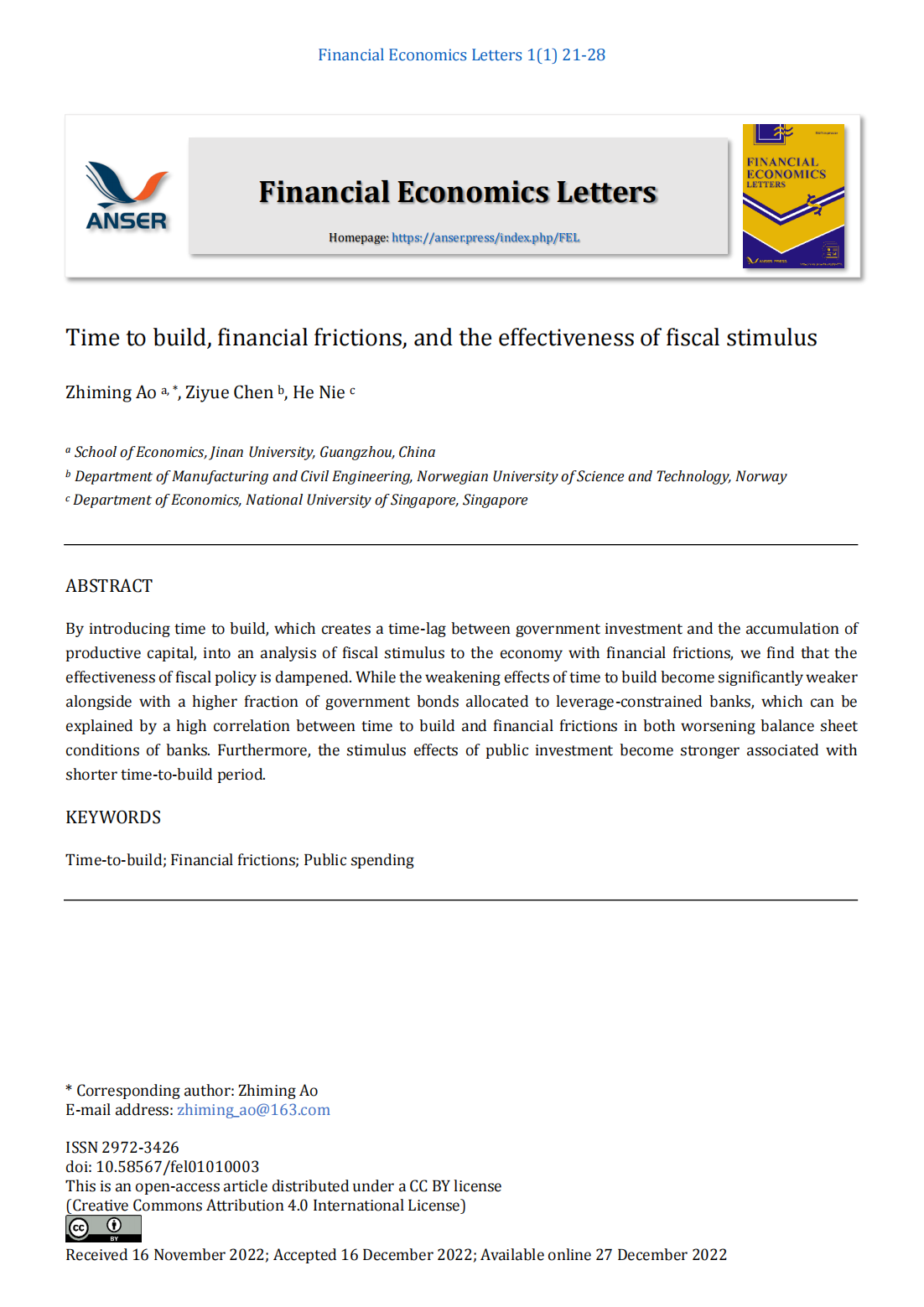Time to build, financial frictions, and the effectiveness of fiscal stimulus
DOI:
https://doi.org/10.58567/fel01010003Keywords:
Time-to-build; Financial frictions; Public spendingAbstract
By introducing time to build, which creates a time-lag between government investment and the accumulation of productive capital, into an analysis of fiscal stimulus to the economy with financial frictions, we find that the effectiveness of fiscal policy is dampened. While the weakening effects of time to build become significantly weaker alongside with a higher fraction of government bonds allocated to leverage-constrained banks, which can be explained by a high correlation between time to build and financial frictions in both worsening balance sheet conditions of banks. Furthermore, the stimulus effects of public investment become stronger associated with shorter time-to-build period.
References
Albertini, J. , Poirier, A. , Roulleau-Pasdeloup, J. (2014). The composition of govern- ment spending and the multiplier at the zero lower bound. Economics Letters, 122(1), 31-35.
Asimakopoulos, P., Asimakopoulos, S. (2019). Fiscal policy with banks and financial frictions. Journal of Financial Stability, 40, 94-109.
Bouakez, H., Guillard, M., Roulleau-Pasdeloup, J. (2017). Public investment, time to build, and the zero lower bound. Review of Economic Dynamics, 23, 60-79.
Christiano, L. J., Eichenbaum, M., Evans, C. L. (2005). Nominal rigidities and the dynamic effects of a shock to monetary policy. Journal of Political Economy, 113(1), 1-45.
Drautzburg, T., Uhlig, H. (2015). Fiscal stimulus and distortionary taxation. Review of Economic Dynamics, 18(4), 894-920.
Gennaioli, N., Martin, A., Rossi, S. (2014). Sovereign default, domestic banks, and financial institutions. Journal of Finance, 69(2), 819-866.
Gertler, M., Karadi, P. (2011). A model of unconventional monetary policy. Journal of Monetary Economics, 58(1), 17-34.
Gertler, M., Kiyotaki, N. (2010). Financial intermediation and credit policy in busi- ness cycle analysis. In Handbook of monetary economics (Vol. 3, pp. 547-599). Elsevier.
Gertler, M., Kiyotaki, N., Queralto, A. (2012). Financial crises, bank risk exposure and government financial policy. Journal of Monetary Economics, 59, S17-S34.
Kirchner, M., van Wijnbergen, S. (2016). Fiscal deficits, financial fragility, and the effectiveness of government policies. Journal of Monetary Economics, 80, 51-68.
Li, J., Li, R. (2018). Time-to-build, consumption complementarity, and fiscal stim- ulus. Economics Letters, 163, 121-125.
Ramey, V. A., Zubairy, S. (2018). Government spending multipliers in good times and in bad: evidence from US historical data. Journal of Political Economy, 126(2), 850-901.
Roulleau-Pasdeloup,J. (2013). The productive government spending multiplier, in and out of the zero lower bound, CREST, No.2013-02.
Sarkar, S., Zhang, C. (2015). Investment policy with time-to-build. Journal of Bank- ing Finance, 55, 142-156.
Sportelli, M., De Cesare, L. (2019). Fiscal policy delays and the classical growth cycle. Applied Mathematics and Computation, 354, 9-31.
Woodford, M. (2011). Simple analytics of the government expenditure multiplier. American Economic Journal: Macroeconomics, 3(1), 135.

Downloads
Published
How to Cite
Issue
Section
License
Copyright (c) 2022 Zhiming Ao

This work is licensed under a Creative Commons Attribution 4.0 International License.
